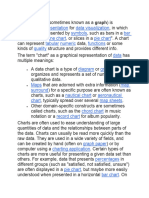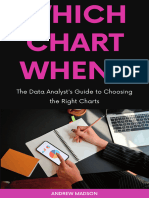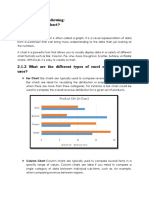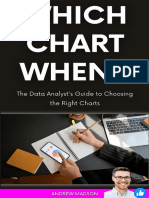1.
Column Chart
Use: Comparing discrete categories.
Example: Sales by month, performance of different products.
Tip: Avoid using for more than 10 categories to keep it readable.
2. Bar Chart
Use: Comparing categories where length matters.
Example: Comparing sales across different regions.
Tip: Useful for longer category names or when emphasizing magnitude.
3. Line Chart
Use: Showing trends over time or continuous data.
Example: Stock prices over a year, temperature changes throughout a day.
Tip: Use to visualize changes and patterns over time.
4. Pie Chart
Use: Showing parts of a whole.
Example: Market share of different products, budget allocation.
Tip: Limit to 5-6 categories for clarity; use when precise proportions matter.
5. Area Chart
Use: Showing trends and relationships over time.
Example: Sales growth over quarters, cumulative data.
Tip: Use to highlight total values and trends over time.
6. Scatter Plot
Use: Displaying relationships between variables.
Example: Correlation between advertising spending and sales, height vs. weight.
Tip: Useful for identifying patterns and relationships in data.
7. Combo Chart
Use: Combining different types of data on one chart.
Example: Sales data (columns) with a trend line (line) showing growth.
Tip: Use when comparing different scales of data or showing correlations.


























































